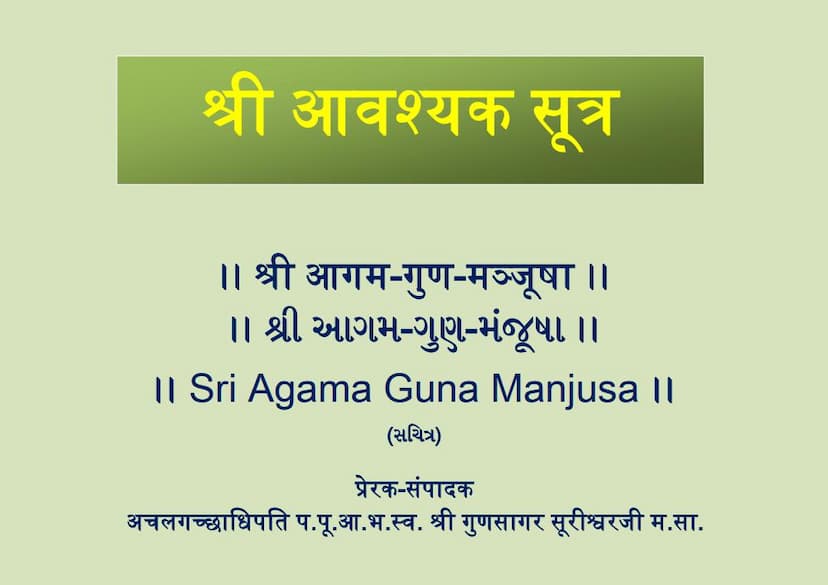Agam 40 Mool 01 Aavashyak Sutra Shwetambar Agam Guna Manjusha
Added to library: September 1, 2025

Summary
This document is a summary of the Jain Agamas, focusing on the Aavashyak Sutra as the first Mool Sutra within the Shwetambar tradition, compiled in the "Agam Guna Manjusha" by Gunsagarsuri. The text provides a concise overview of the 45 Agamas, categorized into Angas, Upangas, Prakirna Sutras, Cheda Sutras, and Moola Sutras.
Here's a breakdown of the content:
Introduction and Overview of the 45 Agamas:
- The document begins by introducing the concept of the 45 Agamas, providing a brief description of each category.
- Eleven Angas: Each of the eleven Angas is listed with its primary subject matter, number of lessons (adhyayana), verses (slokas), and key themes.
- Acharanga Sutra: Focuses on the conduct of monks and householders.
- Sutrakritanga Sutra: Discusses various philosophical viewpoints (ritualists, non-ritualists, etc.).
- Sthananga Sutra: Deals with calculation and enumerates objects from one to ten.
- Samavayanga Sutra: Similar to Sthananga, enumerates objects from one to crores.
- Vyakhya Prajnapti Sutra (Bhagavati Sutra): The largest Agama, in question-answer format between Lord Mahavira and Gautama Ganadhara, covering all four types of 'Anuyogas' (teachings).
- Jnata Dharma Kathanga Sutra: Focuses on religious discourses and narratives.
- Upasaka Dasanga Sutra: Describes the twelve vows and the lives of ten great lay disciples.
- Antakriddasa Sutra: Narrates short life stories of souls attaining liberation.
- Anuttaraupapata Dasa Sutra: Chronicles the lives of great lay disciples who attained the Anuttara Viman and then liberation.
- Prashna Vyakarana Sutra: Involves questions and answers from various beings, focusing on conduct.
- Vipaka Sutra: Describes the fruition of karma through examples of sinful and virtuous souls.
- Twelve Upangas: Brief descriptions of twelve Upanga Sutras are provided.
- Aupapatika Sutra: Describes the city of Champanagari, austerities, and disciples.
- Rajapraśniya Sutra: Mentions King Pradesi and the worship of Jina idols.
- Jivabhigama Sutra: Analyzes soul and non-soul entities and the Jambu continent.
- Pannavaņa Sutra: Describes 36 steps or topics.
- Surya Prajnapti Sutra & Chandra Prajnapti Sutra: Focus on calculation, describing celestial movements.
- Jambudvipa Prajnapti Sutra: Detailed description of the Jambu continent and its divisions.
- Nirayavali Sutra: Describes the war and the rebirths of King Srenika's sons in hell.
- Kalpavataṁśaka Sutra: Life stories of princes and their sons.
- Pushpika Upanga Sutra: Topics related to celestial beings and householders.
- Pushpaculika Sutra: Previous births of celestial beings.
- Vṛṣṇidaśā Sutra: Stories of the Vṛṣṇi dynasty.
- Ten Prakirna Sutras: Descriptions of ten Prakirna Sutras are given, covering topics like final rites, types of death, the significance of Santhara, food intake, death meditation, Indra's praise, and astrological knowledge.
- Six Cheda Sutras: These are listed as Vyavahara Sutra, Nisitha Sutra, Maha Nishitha Sutra, Pancha Kalpa Sutra, Dasha Shruta Skandha Sutra, and Bhatkalpa Sutra. The text emphasizes that the study of these Sutras is restricted to highly qualified monks due to their profound and subtle content, focusing on rules, exceptions, and atonement.
- Two Chulikas:
- Nandi Sutra: Contains hymns, similes for the Sangha, names of Tirthankaras and Ganadharas, and knowledge.
- Anuyogadvāra Sutra: Considered the "key to all Agamas," explaining four types of Anuyoga (explanation) and the path of conduct.
- Four Moola Sutras:
- Dashavaikalika Sutra: A source of nectar for monks and nuns, with two Chulikas.
- Uttaradhyayana Sutra: Contains the final sermons of Lord Mahavira, focusing on detachment and monastic conduct.
- Anuyogadvāra Sutra: (Repeated here, possibly indicating its foundational nature) Discusses conduct and behavior.
- Aavashyak Sutra: Described as the most useful Agama for all four groups of the Jain community, detailing six obligatory duties (Samayika, Chaturvimsati, Vandana, Pratikramana, Kayotsarga, Paccakhana).
Detailed Breakdown of the Aavashyak Sutra (Pages 8-15):
This section provides the actual text (in Prakrit/Sanskrit) and a brief Gujarati explanation of each of the six obligatory duties (Aavashyakas) of the Aavashyak Sutra.
- Chapter 1: Samayika: Focuses on the acceptance of the Samayika vow.
- Chapter 2: Chaturvimsati Stava: Contains verses praising the 24 Tirthankaras.
- Chapter 3: Vandana: Includes the Namaskara Mantra, Guru Vandana, and veneration of Arihants.
- Chapter 4: Pratikramana: Details the process of atonement, including confessions of faults (aticharas) related to various aspects of monastic life and daily activities. This chapter is extensive, listing numerous transgressions and principles of righteous conduct.
- Chapter 5: Kayotsarga: Describes the vow and principles of Kayotsarga (standing immobile).
- Chapter 6: Pratyakhyana: Covers various types of vows and their completion, including Paurushi, Purvardha, Ekashana, etc. It also details the rules for householders (Shramanupasaka) regarding the acceptance of vows and avoiding specific transgressions. This chapter lists specific rules for lay followers, including observing vows like abstaining from violence, lying, stealing, unchaste conduct, and possession, as well as rules for fasting and offering food to ascetics.
Overall Purpose:
The "Agam Guna Manjusha" aims to provide a structured and accessible introduction to the vast collection of Jain Agamas. This specific excerpt highlights the Aavashyak Sutra as a foundational text, particularly detailing its six essential components, which are considered daily practices for all followers of Jainism. The inclusion of Sanskrit/Prakrit text alongside Gujarati explanations makes it a resource for both academic study and devotional practice.